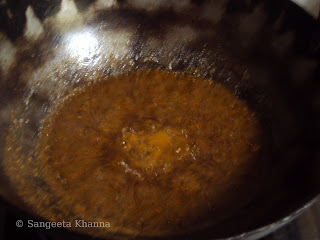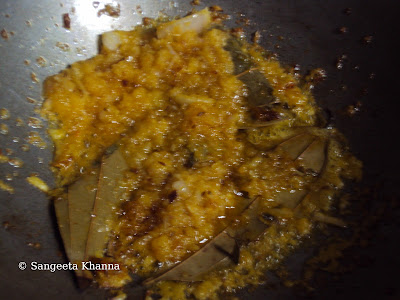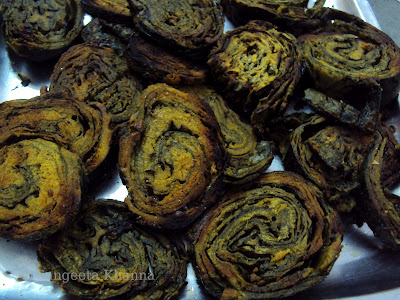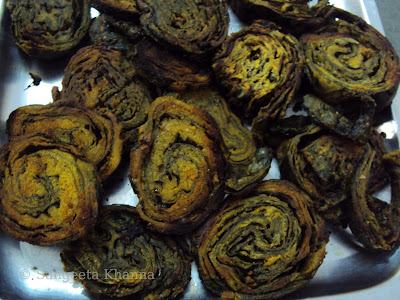Cooking a traditional recipe always warms me up. I love the nostalgia it brings with it, I remember how my grandmother used to make it and then my mother and how all of us siblings would huddle up in the kitchen and be curious. No wonder all of us siblings (two brothers and three sisters in all) are foodies and great cooks. Though when it comes to try the more labor intensive and time consuming recipes it's yours truly who plays granny. And I love doing this and I love when I see happy faces around me. Food always succeeds in spreading happiness. This goojha as we call it at home is a family favorite. It is called fara (singular) or Farey (plural) or pitha in different parts of UP. Bengalis make a sweet version of the same dumpling with a jaggery and coconut stuffing.
I find the fara one of the many dumplings that are made in south-east Asia. Momos, steamed bao, Tingmo or siu mai are all staple foods wherever they are cooked and people find excuses to make such meals even in modern kitchens that trashes the belief that only junk fried foods are liked by all.
I had promised this fara and many of you took interest in this ( I love you all for this )...... an anonymous reader (why anonymous?) said that he/ he will be happy to see if it is with the rice outer shell. I wanted to fulfill this wish so I made the rice flour at home, and tried to cook the rice dough which is a tricky process. Normally I just make a dough of 1:1 ratio of rice and whole wheat and that is good enough to make the fara shells. It took me the whole day rinsing and drying the rice, grinding it and then cooking the dough. Okay about 6 hrs to be precise. It was about about 2 hrs on the kitchen counter and the time spent, the muscle work done was all worth it. We got a whole lot of fara to last a week.

To
make the rice flour at home you need to wash the rice (I used basmati tukda or broken basmati) , drain well in a colander and spread it on a news paper to get a bit dry for about 2 hrs in shade. Test by taking a handful and crushing it in your fist, it should get crushed to smaller bits. Now it's ready to be ground in the dry grinder of your mixie.
You can use ready made rice flour too if available.
The right side heap of rice is crushed by hands to test for readiness.........
chana daal and urad daal were also soaked for 4-5 hours and ground wet in the mixie with appropriate spices.....
Now see the ingredients for the filling...
for urad dal filling
urad dal soaked 1.5 cup
red chilly powder 1 tsp
asafoetida 1 pinch
aromatic garam masala 1 tsp
salt to taste
grind everything together with minimal water .
for the chana daal filling
chana daal soaked 2 cup
green chillies 5 nos.
garlic cloves 5-6 nos.
ginger 2 inch piece
cumin seeds 2 tsp
black pepper corns 2 tsp
salt to taste
salt to taste
turmeric powder 1 tsp
grind everything together with minimal water.
ingredients for the outer shell ..
rice flour 2 cups and some more
whole wheat flour 2 cups or as needed
salt to taste
To make the whole wheat dough you just mix whole wheat flour n rice flour in equal amounts, add salt to taste and make a medium soft dough by adding appropriate amount of water. Adding the rice flour to the wheat dough makes the fara have a nice bite, and it is more moist even when cold.
Making the rice dough is tricky. But rest assured it is very forgiving and you can always nip and tuck the mistakes.....
first of all measure 2 cups of water and salt to taste (for 1 cup of flour) and boil the water covered in a pateela or preferably handi. Don't use a wide pan here.
Click to enlarge the image below to read instruction on it.
As soon as the water comes to rolling boil open the lid and pour the rice flour at once and cover the lid immediately. Do not stir the mix and let it cook for 4-5 minutes or till the water spills off a little. Check that the rice flour lump will look glazed, it reveals rice flour in powder form when poked but that is how it needs to be. Take the pot off the flame.
Now use a large fork or a sturdy ladle or a wire whisk to mix it vigorously.
It may appear lumpy first but be patient and add more rice flour if it's too sticky, don't worry about the lumps as you have to knead it with hands once it is cold enough to handle.
Knead with your hands when it is cool enough to handle.
Make a pliable medium soft dough which you can roll easily, more rice flour can be added but the dough should become smooth. You can oil your hands while doing it.
Now is the time to shape the faras, pull out small portions of the dough, roll small disks about 1 cm thick and place the dal mixture over it, fold and make a semi circle and seal the top leaving the corners open .....
I make them in different sizes and shapes and I prefer filling urad dal mixture in the rice dough and the chana dal mixture in the wheat dough. You are free to have your own combination .
The bigger faras take less time to assemble but more time to cook, I prefer slicing them and frying them for a nice crunchy tea time snack.
There are two ways to cook the fara or goojha, you can either steam them over a steamer plate or boil them in lots of water like you boil pasta. The steaming over a porous plate is explained in the collage above. And boiling in a wide pot with lots of water is explained below.

While you are shaping the faras, boil water (with a little salt and a tbsp of oil) in a big wide pateela, when the water starts boiling slip the faras into it taking care not to scald yourself.
All the dumplings will be submerged in water at once, but they will start coming up as soon as they start cooking. Let it cook for another 3-7 minutes after they float on the surface, 3 minutes for the smaller ones and 7 minutes for the bigger daddies.

Take out one of them and prick with a pointed knife, if it comes out clean it's cooked.
Use a slotted spoon to fish them all out, you may need to boil them in two batches but this is the easiest step and you'd feel like popping one of them in your mouth as soon you fish them out.......

They can be served right away if you want them steamed and it makes a filling satisfying and yummy dinner. I have fond memories of having a large platter of these on the dining table, just out of boiling water and all of us sitting and eating them as if there is no tomorrow.
This time I halved one of the bigger ones and had it just when the second batch was cooking.

It has such a wonderful bite, the covering is a perfect wrap for a soft crumbly spicy filling, a bite into the doughy shell leads to aromatic spicy interiors. A perfect alternative to daal roti, healthier and exotic desi.
I don't even need a chutney with it I like it so much.
A green chutny or even a sonth chutny is a great accompaniment, but I prefer making the filling spicy and no accompaniments whatsoever.
Yeah it is a different story with the fried ones. I generally fry the refrigerated ones, you know I make them for a week as I can't have enough of them in one go.
It keeps very well in the fridge and you can fry the smaller ones whole and the bigger ones can be sliced and fried to make exotic tea time snacks. They don't absorb oil and as you drain them on tissue paper any oil clinging to the surface is also absorbed by the tissue.
We had these for the evening tea.
These are so filling that you are free for 4-5 hours after having 2-3 of the smaller ones .....
The covering becomes a bit hard and crunchy after frying, without taking any oil and we love it.
It is after years that I have made them, though I was thinking of making these for a long time. Ravioli pasta and other types of dumplings I used to make a lot but these fara (goojha) brought many memories along and that made the meal even more special.
The urad daal and rice combination is softer and milder in spice level. I used just a hint of garam masala and the hing flavor combines very well with urad daal, making it tastier and easier for the tummy as well. I like the urad one more but Arvind likes the chana dal one. Tell me which one you'd like to have ....
PS : In our home it is called goojha as it is shaped like a gujhia. I have seen many people in banaras call it fara and bengali friends and a few bihari friends call it peetha. Now this anonymous reader has come up with another name,
gointha. It was great to know this name and hilarious too, as gointha is a name for cow dung cakes used as fuel in the rural areas. They are made into the same shape and may be the name is inspired by that.
What's in a name when the end product is so yummy. You make it for a week and enjoy it any way you like Warm it with a sprinkling of water in microwave and enjoy it steamed for dinner with a soup may be, or fry them for a snack.
A blogger friend says that the best way to learn is to share your knowledge. I experienced it when I shared the recipe of
patode. I knew only about the gujrati patra till now and after posting the recipe I came to know about the konkani and mangalorian pathrode as well. Many of your comments indicated that there are so many versions of this recipe and it is so heart warming to see this diversity with the same ingredients. I am sure that I will be knowing many more types of peethe too now, I know there is a different version in almost every state of India. But I have known only about the bengali peethey so far. What about your kind of peethey or any such dumpling ?? Had you known this Fara or goojha? Or you also know it as pitha or peetha?
Come on tell me. Iwelcome your links too if you have posted the recipe already on your blogs.
PS once more : I made these fara or pitha again for a get together ta home and decided to click more pictures. Uploading this post with a few better pictures so the process and the texture of this goojha of my home town is more understandable to someone clueless about pitha, or fara, or goojha or goitha :-)





















































